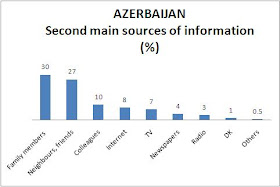Despite some international criticism on media freedom, nationwide survey data shows that Azerbaijanis seem to be generally satisfied with certain forms of national mass media—although with a few exceptions. The overall picture that emerges from the 2011 Caucasus Barometer in Azerbaijan is that 44% of the population thinks TV journalists inform the population well, 32% are neutral, and 16% say TV journalists do not inform the population well (7% don’t know). A 2012 survey conducted by CRRC on Social Capital, Media and Gender (download at http://www.crrccenters.org/activities/research/?id=70) highlights some interesting facts about how Azerbaijanis use mass media and how they stay informed.
Taken together, channels of information such as television and personal networks remain favored by a majority of the population, whereas new media such as the internet still plays a minor role. Television is the preferred main source of information by 90% of the population. This is followed by informal personal networks such as family members and neighbors/friends that are preferred by 30% and 27% of the population, respectively, as their second main source of information. These ways of obtaining information far outstrip the internet or printed media (e.g., newspapers).
Source: Social Capital, Media and Gender in Azerbaijan, 2012
Television plays a pivotal role in Azerbaijan since the majority of the population uses it as their main source of information. Moreover, when asked to assess the level of importance for media to freely publish news and ideas without government control, 75% of Azerbaijanis think this is very important for TV. This is followed by fewer people who say that this freedom is very important for the radio (23%), internet (34%) and newspapers (27%).
In general, newspapers are less preferred in the country. 79% of Azerbaijanis do not read newspapers at all, 10% read them but not daily, and the other 11% say they read newspapers at some point on an average day. This indication of discontent with printed media seems to be stronger in rural regions where the percentage of those who do not read newspapers at all increases to 87%. The most common reasons people give for not reading newspapers are little interest (37%), not enough time to read them (21%), insufficient distribution (14%) and a lack of money (11%).
Source: Social Capital, Media and Gender in Azerbaijan, 2012
Another interesting result that has emerged from the data is that general internet use is low in Azerbaijan. 64% of Azerbaijanis never use the internet and 11% say they don’t know what the internet is. Out of those who say they never use the internet, slightly more are women (55%) than men (45%). 17% use the internet at least once a week (up from 10% in 2010) and 7% access the web at most once a month.
The so-called digital divide which refers to inequalities within a society in terms of access to or knowledge of information and communication technologies is one of the reasons for the low level of internet usage in the country. 34% of Azerbaijanis have limited or no access to a computer or mobile phone (these two items were asked about within the same question), and 10% do not use the internet due to old age. Moreover, 27% of the population says that it has no interest using the internet. However, interestingly the level of education is positively associated with internet usage as 62% of adults with a degree above a Bachelors use the internet at least once a week.
Source: Social Capital, Media and Gender in Azerbaijan, 2012
More trends emerge with regard to radio usage. 56% of the population listens to news on national radio channels at least once a week and about 10% listen to regional channels for news. However, much of the population listens to the radio for entertainment such as popular (83%) or classical (61%) music.
In summary, Azerbaijanis still prefer to rely on television and personal networks to obtain the news. It will be interesting to observe if Azerbaijan will follow the same path as many western countries in which there is an increasing importance of new media or if it will continue to place primary importance on TV and personal networks.



No comments:
Post a Comment